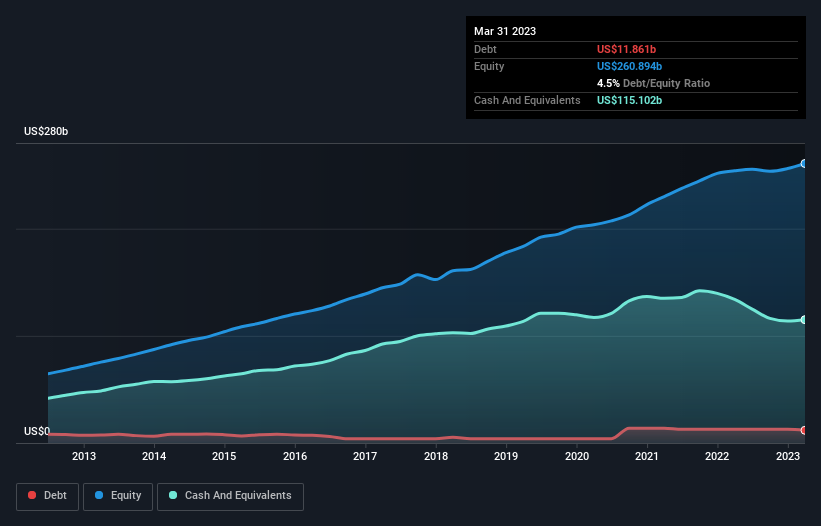Alphabet (NASDAQ:GOOGL) Seems To Use Debt Quite Sensibly
The external fund manager backed by Berkshire Hathaway's Charlie Munger, Li Lu, makes no bones about it when he says 'The biggest investment risk is not the volatility of prices, but whether you will suffer a permanent loss of capital.' So it might be obvious that you need to consider debt, when you think about how risky any given stock is, because too much debt can sink a company. We note that Alphabet Inc. (NASDAQ:GOOGL) does have debt on its balance sheet. But should shareholders be worried about its use of debt?
When Is Debt Dangerous?
Generally speaking, debt only becomes a real problem when a company can't easily pay it off, either by raising capital or with its own cash flow. If things get really bad, the lenders can take control of the business. While that is not too common, we often do see indebted companies permanently diluting shareholders because lenders force them to raise capital at a distressed price. Of course, plenty of companies use debt to fund growth, without any negative consequences. When we think about a company's use of debt, we first look at cash and debt together.
See our latest analysis for Alphabet
How Much Debt Does Alphabet Carry?
You can click the graphic below for the historical numbers, but it shows that Alphabet had US$11.9b of debt in March 2023, down from US$12.8b, one year before. But on the other hand it also has US$115.1b in cash, leading to a US$103.2b net cash position.
A Look At Alphabet's Liabilities
We can see from the most recent balance sheet that Alphabet had liabilities of US$68.9b falling due within a year, and liabilities of US$39.7b due beyond that. Offsetting these obligations, it had cash of US$115.1b as well as receivables valued at US$36.0b due within 12 months. So it can boast US$42.5b more liquid assets than total liabilities.
This surplus suggests that Alphabet has a conservative balance sheet, and could probably eliminate its debt without much difficulty. Succinctly put, Alphabet boasts net cash, so it's fair to say it does not have a heavy debt load!
But the bad news is that Alphabet has seen its EBIT plunge 12% in the last twelve months. If that rate of decline in earnings continues, the company could find itself in a tight spot. When analysing debt levels, the balance sheet is the obvious place to start. But ultimately the future profitability of the business will decide if Alphabet can strengthen its balance sheet over time. So if you want to see what the professionals think, you might find this free report on analyst profit forecasts to be interesting.
Finally, a company can only pay off debt with cold hard cash, not accounting profits. Alphabet may have net cash on the balance sheet, but it is still interesting to look at how well the business converts its earnings before interest and tax (EBIT) to free cash flow, because that will influence both its need for, and its capacity to manage debt. During the last three years, Alphabet generated free cash flow amounting to a very robust 89% of its EBIT, more than we'd expect. That positions it well to pay down debt if desirable to do so.
Summing Up
While it is always sensible to investigate a company's debt, in this case Alphabet has US$103.2b in net cash and a decent-looking balance sheet. And it impressed us with free cash flow of US$62b, being 89% of its EBIT. So we don't think Alphabet's use of debt is risky. Over time, share prices tend to follow earnings per share, so if you're interested in Alphabet, you may well want to click here to check an interactive graph of its earnings per share history.
Of course, if you're the type of investor who prefers buying stocks without the burden of debt, then don't hesitate to discover our exclusive list of net cash growth stocks, today.
Have feedback on this article? Concerned about the content? Get in touch with us directly. Alternatively, email editorial-team (at) simplywallst.com.
This article by Simply Wall St is general in nature. We provide commentary based on historical data and analyst forecasts only using an unbiased methodology and our articles are not intended to be financial advice. It does not constitute a recommendation to buy or sell any stock, and does not take account of your objectives, or your financial situation. We aim to bring you long-term focused analysis driven by fundamental data. Note that our analysis may not factor in the latest price-sensitive company announcements or qualitative material. Simply Wall St has no position in any stocks mentioned.
Join A Paid User Research Session
You’ll receive a US$30 Amazon Gift card for 1 hour of your time while helping us build better investing tools for the individual investors like yourself. Sign up here

 Yahoo Finance
Yahoo Finance 
